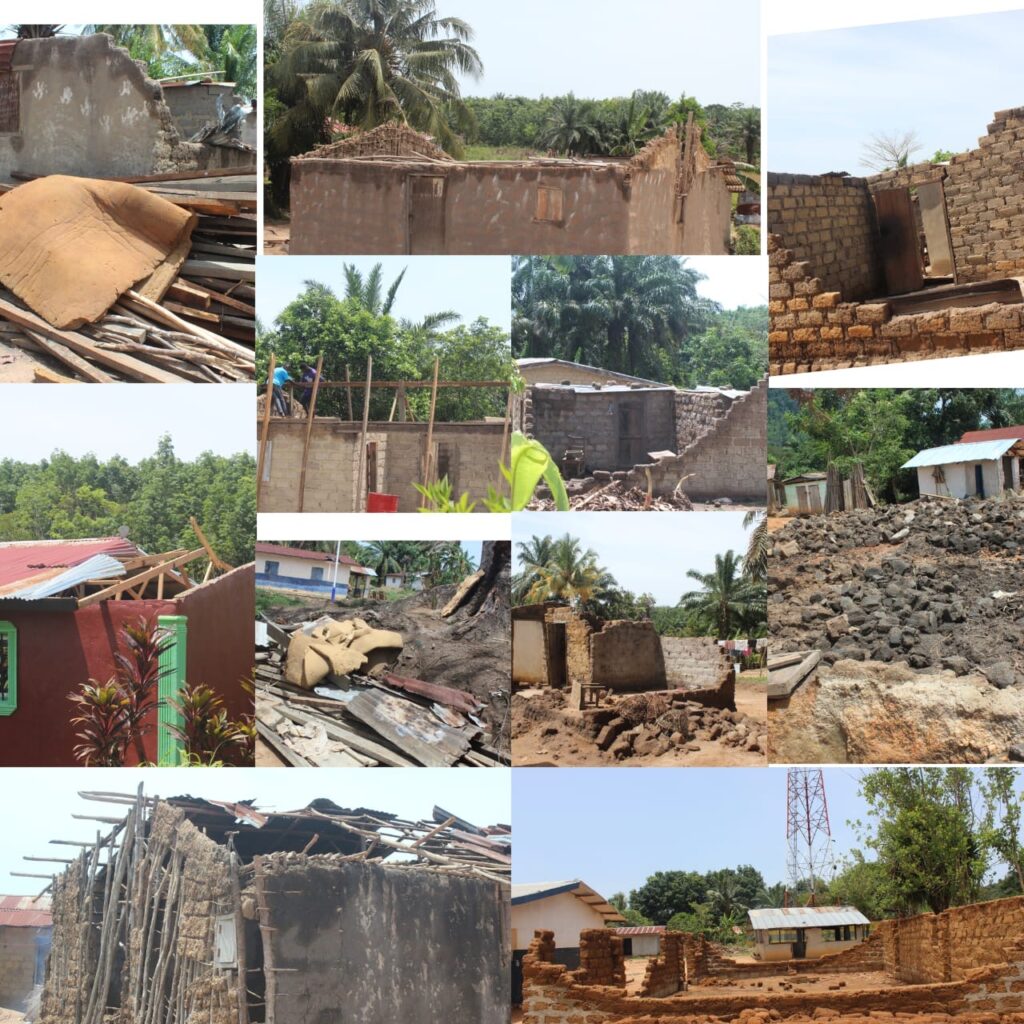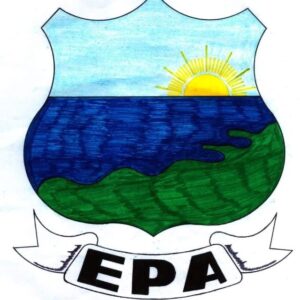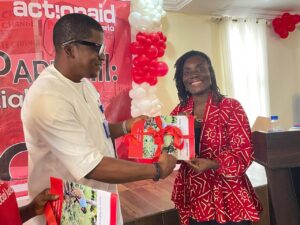Windstorm Afflicts Garmu, Leaves Residents Stranded

By Laymah Kollie
Bong County: It is early Saturday morning when most people normally take a breather from the week’s routine and frenetic pace of life! But as a journalist, duty always calls for me and my colleagues!
To keep everyone informed, and up to date on everything, we are on the front lines gathering, analyzing, digesting, and distributing news. And it does not matter what it takes.
Ever burning with ambition and chasing that career-defining scoop, I quickly took my phone even before I could get out of bed, and called my colleague (Matalay Kollie). As if he was waiting for my call, he took it on the first ring saying: “wassup(how are you?)” “I freh ooo (I’m okay ooo),” I responded.
We continued with our banter as I tried to convince him to join me on this trip in search of a big story.
Me: wetting u doin lay morning? (What are you doing this morning?).
(Matalay): natin much, tuday Sataday so I on crib (nothing much, today is Saturday so I’m at home).
Me: I wan us go Garmu mehh, u can makay? (I want us to visit Garmu mehh, are you available?).
(Matalay): yea!, me: ok, pls coney bike for us(okay, please contact a motorcyclist for us).
Yeeee, I screamed in excitement as I jumped out of the warm duvet into the bathroom for a quick shower. I quickly put on a black pair of jean trousers, sneakers and picked my tools of trade as I headed to the door to the jungle to hunt for the story.
Even when I hurried to catch up with my friend, at the back of my mind, this day, March 23, 2024, would be on a routine feature assignment to document what was left for a once-thriving town, which was now a pale shadow of itself after desertion by an iron ore mining company that operated in the area for close to five years.
The journey to Garmu, was a bumpy and gusty ride on a motorcycle– locally known as bike on the revving two-wheel machine. I caught an image of Big Jue even as I clutched tightly to my rider’s jacket as it chewed the road snaking through to the God-forsaken town in the jungle.
Garmu town is situated in Panta Administrative District, in Bong County electoral District#4 around the border region between Liberia and Guinea.
The town, which sits on the shoulders of a scenic mountain – Gar- from which it takes its name, is a home to more than 2,000 people. It is divided into seven quarters– Kpoquoi #1, Kpoquoi #2, Balaquoi #1, Balaquoi#2, Gailequoi, Gbelequoi and Gbarnahquoi.
In our estimation, it was going to be a 45-minute adrenaline-filled ride–-and all that occupied our minds as we inhaled fresh air rushing out of the forest was how to package an award-scooping story.
As we got closer to the town, villagers, who dotted either side of the road beneath tall trees swaying back and forth, tried to entice us and other potential customers to buy their palm wine.
But little did we know what awaited us. Soon, it dawned on us that our feature would be swept away by a breaking story of a windstorm, which had descended on the village.
From the forlornness of a lost prosperity and livelihood, the helpless villagers had now to deal with the fury of petulant Mother Nature!
We were greeted by an air of sadness and eeriness – momentarily, we were paralyzed by shock and disbelief at the destruction visited on the village.And as if glued to our seats by sheer shock, all we could say was; “Oh, my God!”
But our journalistic instincts quickly triumphed over human empathy, and we jumped off the motorbike with our paraphernalia – cameras, phones, notebooks and pens– to document the tragedy that had befallen Garmue!
Everywhere, everything and everyone bore the evidence of Mother Nature’s unexplained vengeance of unfathomable proportions. As we walked through the village in utter silence but with our antenna up to capture every detail of the unfolding story, we saw several broken houses; some completely damaged, some with ripped off roofs and scarred walls left standing.
Along the way, we met a middle- aged man dressed in traditional regalia, who appeared to be carrying the burden of the tragedy on his shoulders. Pain was written all over his face and seemed to be avoiding eye contact with us. His name was Chief James P Sumo, one of the Quarter Chiefs of the Seven Quarters in Garmu Town.
With an anxious grin, I said, Ya` tuwa ( hello) to him. But instead of responding promptly, he hesitated as if weighing the meaning of the greeting in his mind as he stared at us. Finally, he responded: “Allah ha`layee`” (by God’s grace, I am trying).
Though an awkward question, I enquired to his astonishment: “This is Garmu, right?” To which he responded curtly, “ yes!”
A malevolent force appeared to have descended upon Garmu, inflicting misery, ruin, and desolation upon its inhabitants. As far as the eye could see, the city bore witness to this catastrophic event; people, houses, roads, and open grounds, all bore the scars of destruction.
Though it seemed to many, it had just been seven years since the departure of an Australian firm– Iron Ore Concession Company BHP Billiton– which had set base in the town from 2010 to 2016, closed shop.
Chief Sumo watched us with keenness and when he realized that we were on a mission, he, too, decided to brave the sweltering mid-morning heat and joined us on the walk across the village. We walked in silence on the debris of destroyed houses and felled trees.
Suddenly, I stood and asked Chief Sumo: “What happened?”
In a heavy tone, he said the town was stripped by a violent storm on March 17, 2024, adding that 82 houses were destroyed leaving more than 500 people homeless.
According to the Quarter Chief of Kpoquoi #1, four people were critically injured besides the extensive damage to the Annex, the only elementary school in the area.
Amongst the 82 affected houses, 45 were badly damaged and 37 partially.
Chief Sumo said this was not the first time the inhabitants had experienced such a disaster,adding that a similar one hit the area in 2022 badly affecting 53 houses with over one hundred homes.
One of the victims, Peter Paye, 40, who was busy trying to rebuild his damaged house, said his wife was nursing injuries suffered as she tried to escape from the house when the walls started cracking.
“We don’t have a place to sleep in since the rain destroyed our house. I am now trying to fix this kitchen for my family to shelter in, but it is not easy,” said Peter in a distressed voice.
Madam Gamai Julee, another victim, described the complex challenges the disaster posed to her. A single mother of three, she said lost everything and had no one to turn to for help.
“Right now, I don’t even know how I’m going to start this process. I do farm work to feed my children and I, we don’t make much money from harvest these days,” she added.
Gbark Mator, a widow of nine children, described the incident as painful. Ma Mator, who survives on a small business, said it has been tough surviving even as she tries to rebuild her house and life.
“I sell small small things, when people bring their goods, I buy it from them and resell it for me and my children to eat. My husband died and I am unable to raise money to rebuild a full house,” she said.
The villagers blamed their never-ending plight on deforestation.
Weeko Kollie, assistant in the office of the General Town Chief of Garmu, said the village started suffering the curse of the windstorm after BHP Billiton vacated the area.
He added that the company felled many of the trees around the mining site leaving the ground bare and thus exposing it to windstorms.
He said before the company’s activities in the town, the tree cover on the mountain and surrounding areas provided protection against violent storms by reducing wind speed. The town had never experienced such storms prior to the company’s operation.
“The forest used to protect us from the strong wind. But the trees on the mountain were cut down by the mining company. Right now when the wind comes, there’s no tree to protect our houses,” said Kollie.
Also, residents, most of them farmers, are to blame, too. They have invaded and cleared the remaining forest to plant cash crops such as pepper, bitterball, okra and palm oil. Charcoal burning, a main source of domestic energy and income, is also rampant.
To mitigate the situation, the National Disaster Management Agency of Liberia recently issued a warning to the public saying 100,000 people are likely to suffer flood, windstorm and coastal erosion this year.
According to a World Bank Group 2024 report, Liberia was Under SSP3-7.0 projected to experience a spike in temperatures between 1995 and 2014. It also added that it would peak at 2.10°C between 2040- 2059 with dires consequences among them extreme heat risks and more frequent and intense precipitation intensities.
It warned that such conditions would pose risks to food security, enhance flood-related threats, emergence of disease outbreaks, threat to biodiversity and compromise living conditions.
Other climate-related hazards, include rise in sea level rise and coastal inundation that will increasingly threaten Liberia’s extensive coastal zones and urban areas. It further warned the country will experience frequent and intense floods and droughts.
For Garmu and other areas, the projected climate-related hazards seem to have struck home sooner than expected with frequent and intense windstorms being experienced in the area.
For instance, last month, several people were rendered homeless after 298 homes were destroyed in Gbarpolu County, 37 in Nimba county.
In response to the climate change, the Government of Liberia through the National Disaster Management Agency has been issuing early warnings to the public using radio jingles to spread awareness on what citizens need to stay safe.
“Let the people take heed, strengthen the roofs on their houses, build houses with thicken roofs. We are telling them to go to the bushes, get strong robs and tie their roofs to avoid the wind. Climate change is the cause,” said Archievego Doe, the agency’s director of communications.
“You will see more of this. Aside that there will be serious folding at the west and south coast of Liberia. Reduce deforestation, don’t cut all the trees down. Farmers must learn to replant trees. We can’t say “stop it, reduce it”.
Doe adds that climate change is real and Liberia is signatory to many climate change pacts, including the Paris Agreement, besides being in the forefront in efforts to mitigate effects of climate change for the wellbeing of its citizens, region and globally.
However, experts fear that there would be more disasters in the near future unless measures are taken to arrest the situation. According to climate change expert, Abayomi B C Grant, Liberia needs to fully implement policies and laws on climate action. He adds that unless urgent measures are taken, there will be intense disasters in the future that may lead to loss of property and lives.
“If we are not careful we will experience more storms and more disasters and that would lead to a loss of property and lives,” he says.
In its revised NDC, Liberia commits to reducing its economy-wide greenhouse gas emissions by 64 per cent below the projected business-as-usual level by 2030, through a combination of the following: unconditional GHG reductions of 10% below BAU, resulting in an absolute emissions level of 11,187Gg COze in 2030; with an additional 54 per cent reduction conditional upon international support, which would result in an absolute emissions level of 4,537Gg COze in 2030.
This commitment is constructed from GHG mitigation targets across nine key sectors – Agriculture, Forests, Coastal zones, Fisheries, Health, Transport, Industry, Energy, and Waste – as well as cross-cutting targets for urban green corridors. The NDC also includes climate change adaptation targets for eight sectors – Agriculture, Forests, Coastal zones, Fisheries, Health, Transport, Energy, and Waste – as well as cross-cutting targets for urban green corridors. The NDC outlines a national system for measurement, reporting, and verification (MRV) for mitigation actions and monitoring and evaluation (M&E) for adaptation actions to implement the NDC. It also stated the policy and institutional arrangement for the implementation and added analysis of its co-benefits of adaptation and mitigation, and as well the direct and indirect investment needed to implement the NDC.
In the Forest sector, Liberia commits to the following mitigation targets to reduce GHG emissions from and enhance carbon sinks in forested areas: to reduce the national deforestation rate by 50% by 2030, and to reduce GHG emissions from forest conversion by 40% below BAU levels by 2030 (Reduction of 5,147 GeCO.e in 2030).
Also, reforest an average of 12,285 ha per year to enhance forest carbon stocks by 1,013 GgOe in 2030, including through natural regeneration and tree planting through community and school programs, restore 25% of priority degraded forest by 20230 and enhance carbon stocks by 600 Gg, COze through annual carbon sequestration in the urban canopy and the planting of additional trees in urban green corridors.
Liberia is also signatory to International Policies that seek to address climate change. It is signatory to the Paris Agreement and a party to the United Nations Framework Convention on Climate Change (UNFCCC), the Kyoto Protocol amongst other Instruments.
However, commenting on the implementation of the NDC,Jefferson Nyandibo, Head of the Multilateral Environmental Agreement Management at the Environmental Protection Agency said the EPA is yet to conduct a latest review on the implementation progress since it was revised in 2021.
He added that NDC in collaboration with other stakeholders need to capture data on the progress made in various sectors to guide climate change mitigation measures.
Even though as prescribed in the NDC, Liberia is charged to conduct a review in June of 2024, but Nyandibo says it might not be possible as it lacks resources.
He says Liberia is yet to receive intervention from annex 1 parties to some of these crucial sectors.
“We are trying to do our NDC latest review. We need to do a review to know from 2021 till now what has been achieved in the various sectors. The review has not been done. For now I can say the NDC is well underway, even though some of the sectors are yet to receive intervention from annex1 parties. The review is expected to take place in June 2024, but it’s unlikely that EPA will host the review process in June due to insufficient funds.
In the Paris Agreement Annex1 Parties are developed countries while Annex 2 are least developed countries. The NDC implementation is based on two targets: Conditional constituting 85% and Unconditional constituting 15%.
Conditional targets of the NDCs say that Liberia as a country will not be able to do certain things until it receives fundings from the annex 1 parties. Unconditional targets talk about Liberia as a country will be able to do certain things.
Article 4.5 of the Paris Agreement states that developed countries (annex I) provide support to developing countries in order to implement targets of the Nationally Determined Contributions.
In terms of efforts applied in reforestation as prescribed in the NDC, the Forestry Development Authority (FDA) of Liberia highlighted the protection of remaining forest by laws, and other plans they are currently working on.
According to Shelton Gonkawon, Director of Communications at FDA, natural disasters are uncontrollable, adding that they are educating the citizens on resilience. He also stated that there are plans to empower rangers to protect forests.
“The forest has been guided heavily by the laws. We just concluded a weeklong tour to the Sarbo National Park in Sinoe. We went to all the places, we had meetings with the rangers. They are trying to empower the rangers.
We can’t control nature, it has its own frequency, it has its own speed and direction. What we do is we control the minds of the people. What we tell the people is don’t cut the trees. We are educating the people,” said Gonkawon.
According to www.statista.com as of May 2022, 45 African countries had submitted an updated version of their first Nationally Determined Contributions (NDCs), indicating their commitment to reducing greenhouse gas emissions in order to limit the increase in global temperature. Since the adoption of the Paris Agreement in 2015, countries have agreed to make new climate commitments every five years . In Africa, Cote d’Ivoire was the last country to release an updated NDC. Algeria, Botswana, Egypt, Equatorial Guinea, Eritrea, Djibouti, Gabon, Lesotho, and Madagascar have submitted only their first NDCs. Lastly, Libya was the only country in the African continent that did not submit any NDC.
Like Liberia, Nigeria submitted its first NDC in 2015 and the revised NDC in 2021.



